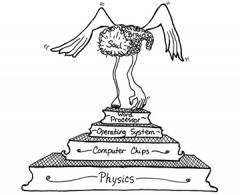
This Article From Issue
May-June 2006
Volume 94, Number 3
Page 267
DOI: 10.1511/2006.59.267
World As Laboratory: Experiments with Mice, Mazes, and Men. Rebecca Lemov. vii + 291 pp. Hill and Wang, 2005. $30.
What do two-headed worms, laboratory experiments on babies, miniature mazes, thinking machines, "coercive stimuli," remote-controlled cats and military-sponsored anthropologists have in common? Each, according to Rebecca Lemov, was a key instance in the service of a 20th-century idea:
If one could quantify and control the internal arena of the personal self—its urges and wants, its worries and fears—then the running of a modern society would require less brute external force. In the long term, putting this idea into practice would make it possible to regulate human beings in tune with the needs, demands, desires, and models of the social order, so that people would want to do whatever they were instructed to do (for example, to die for one cause, shop for another...).
Lemov, an anthropologist by training, delves into the history of this idea, from its origins in the agricultural hybrids of Luther Burbank at the turn of the century to its expression in behaviorist psychology in the first three decades of the 20th century and eventually to the most disturbing and science fiction-like scenarios, of which Stanley Milgram's 1961 "obedience to authority" experiments, wherein the social scientist easily convinced laboratory subjects to administer electrical shocks to total strangers, are only the best known.
As she details in her often fascinating book, World as Laboratory, scientists began their quest to remake life by probing plants and lower-order animals such as sea urchins. They moved on to the white rat—the first creature bred for the laboratory—and then tentatively but restlessly transferred their gaze (and their instruments) to human beings as the century marched on.
Taking a breezy biographical approach, the book follows the connections among teachers and students, collaborators and colleagues to trace the strange career of social engineering. Lemov's narrative is lively and packed with characters who were visionaries or eccentrics, depending on one's point of view.
In contrast to much of the existing literature on the history of the social and behavioral sciences, Lemov tracks not a scientific discipline or community but an ambition, ages old but seemingly newly within the realm of possibility: to refashion human beings from the outside in. She persuasively documents how principles derived from Jacques Loeb's study in the early 20th century of plant tropisms—for example, the tendency of leaves to orient themselves toward the sun—led in fits and starts to a full-blown technology of human behavioral engineering. This was a science premised on the notion that behavior could similarly be shaped, not by sunlight but by an experimental scientist who controlled and moderated the surrounding environment. Such efforts found fruition, among other places, in the bizarre brainwashing and hypnosis programs of the CIA during the Cold War and in Timothy Leary's mind-opening experiments with LSD at Harvard.

From World As Laboratory.
Behaviorism—the faith that actions (rather than thoughts, impulses, unconscious urgings or the like) are the raw material of psychological science—provides the common, albeit loose, thread. John B. Watson, Loeb's famous student, made this faith plain in his claim that adult humans could be manufactured from scratch through the proper "conditioning" of fear, love and anger in babies. A generation of like-minded psychologists, psychiatrists, anthropologists and sociologists gathered around experimental psychologist Clark Hull at Yale's Institute for Human Relations in the 1930s. Funded by Rockefeller monies, they put theories of "behavioral feedback" and "aversive conditioning" to work in realms as diverse as race relations in the Deep South and "human relations" on the factory floor. They even, according to Lemov, invited a certain version of Freudianism into their fold, transforming it in the process.
World War II propelled behaviorists, especially those working at the intersection of culture and personality, into national bureaucracies and far-flung corners of the world. Ever more sophisticated in their descriptions of the mechanism regulating the organism's relation to the environment, researchers remained riveted on an overwhelmingly simple premise: that a stimulus, properly administered, provokes a predictable response.
Ample funding and willing researchers were available, but for behaviorism to gain traction, suitable showcases for its enactment were also required. Laboratories, Lemov asserts, were the sites where theory and practice came together in startling ways. These were the places—often hidden from public view—where study participants were subjected to restraining devices, problem boxes, galvanic skin-response recorders and "punishment grills" designed to simulate the real world, and where scientists acted out their dreams of revising humanity.
But this was just the first act of a larger drama, according to Lemov. As she sees it, once behaviorist ideas had been invented and polished in sterile laboratories, they were then unloosed in the world, finding their way into government-sponsored counterinsurgency plots and drug-induced behavior modification, and ultimately into advertising campaigns, public relations strategies and "the kind of reality people now inhabit." Writes Lemov, "Every department store, every classroom, every enclosed social situation, every personal encounter has become a potential laboratory."
The weakest link in World as Laboratory is this blurry final step: the notion that mid-century behaviorism left the realm of experiment in the 1960s to fundamentally reshape contemporary life in the image of the claustrophobic control chamber. There may be a grain of truth here. But do market research, personality tests and focus groups really exert the same kind of power over us that the white-coated Milgram exercised over his laboratory subjects? Wouldn't the behaviorists be just a bit disappointed by the feebleness (and imprecision) of what they are claimed to have wrought?
Lemov is at her best in undermining the analogies that psychologists and other social scientists made between artificial mazes designed for rats and the complex labyrinth of human social life, between the effects of disorienting contraptions on pigeons and the effects of stress on individuals, between laboratories and real life. She is less successful at pinpointing the social forces—rather than the individual biographical quirks—that made such substitutions imaginable, and she is less successful still at examining contemporary challenges or alternatives (scientific and otherwise) to such reductions of human existence. At times, lapsing into the passive voice, Lemov suggests that the juggernaut of social engineering had neither authors nor critics nor even resisting subjects: "The goal was the reconfiguration of human behavior and eventually all human capabilities, so that man-within-the-environment was no longer a fact simply to be accepted but an assemblage to be changed"; and, "Eventually the more generous impulses of social science . . . were largely transformed into their opposite: to winnow down, to prevent, and to build systems of control, adjustment, and persuasion, escape from which would be ever more unlikely."
In the end, the story Lemov tells is a bit too conspiratorial, and her vision of human engineering too unidimensional, to be fully convincing. What is more intriguing about her history is that so many scientists arrived at behavioral schemes via divergent routes and were emboldened by different agendas (including, she often seems to argue, their own distressed psyches). Equally striking is how very often their plans failed, despite their grandiose fantasies of control and mastery. Not only were the brave new worlds of Watson, Hull and Milgram disavowed by their social-scientist heirs, but there is little evidence that, even at the height of modernist confidence in social science, human engineering scored any lasting successes (apart from acquiring major monetary grants and popularizing the hypothesis that when people experience frustration from one source, they lash out in aggression elsewhere). It is certainly suggestive of an intellectual sea change that in the wake of World War II a 41-person team of anthropologists, ethnographers, sociologists and human geographers was employed by the U.S. Navy to test out theories of culture and personality and to advise the admirals on the civil occupation of Micronesia. But it is just as revealing that the researchers seemed to have little long-term effect, apart from producing a handful of scholarly articles. Lemov notes: "What Admiral Nimitz or the navy . . . made of these investigations is not recorded in detail."
As critical as she is of the godlike stance of human engineers toward their subjects, Lemov in these instances seems almost taken in by them, giving more weight to their posturing (their "unnameable but certain potency") than to their impact. In fact, again and again she shows that behaviorist aspirations outstripped the evidence for them. Watson's attempt to build better babies revealed mostly the driving force of a hope rather than its realization, as did Canadian psychiatrist D. Ewen Cameron's aim of reprogramming individuals by wiping their memories clean. Indeed, reading World as Laboratory, one begins to see that even if the threat of Communist brainwashing had never existed, it would have been conjured up by U.S. social scientists, who by the 1950s had been schooled for decades about the malleability of minds in the face of their own techniques of manipulation.
What Lemov's provocative book alerts us to above all is the persistence and potential repercussions of an idea, especially when that idea accrues grants, research centers and intellectual authority. Writing of a time when social scientists were called to embrace the "real," Lemov makes an elegant case that they instead fell under the enduring sway of a particular intellectual fiction—that human beings might be fully controlled, given the right set of stimuli and the proper application of behaviorist tools.

American Scientist Comments and Discussion
To discuss our articles or comment on them, please share them and tag American Scientist on social media platforms. Here are links to our profiles on Twitter, Facebook, and LinkedIn.
If we re-share your post, we will moderate comments/discussion following our comments policy.